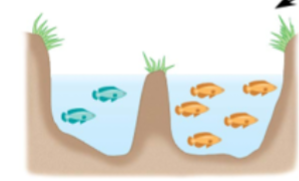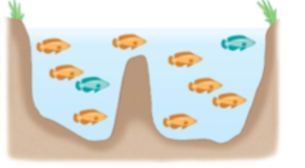Ib 104 Unit 2
1/34
There's no tags or description
Looks like no tags are added yet.
Name | Mastery | Learn | Test | Matching | Spaced |
|---|
No study sessions yet.
35 Terms
what does true breeding mean?
when plants are self-pollinated, this causes offspring to be the same variety as the parent.
what is the genetic basis of a true breeding parent?
two alleles that are the same
what is the genetic basis of the F1 generation hybrids?
two different alleles
what is a phenotype?
an observable trait
what is a genotype?
genes responsible for traits
Prezygotic Barriers
habitat isolation, temporal isolation, behavioral isolation, mechanical isolation, gametic isolation- no successful mating or fertilization
postzygotic barriers
reduced hybrid viability, reduced hybrid fertility, hybrid breakdown- individuals or their offspring are not fertile

allopatric speciation
populations are geographically isolated, gene flow is interrupted from habitat change or colonization.

sympatric speciation
speciation occurs in populations that live in the same geographic area
a species
a group of populations whose members have the potential to interbreed in nature, produce viable fertile offspring, and do not produce viable offspring with members of other such groups
Phylogeny
the evolutionary history of a species or group of related species
systematics
a discipline focused on classifying organisms and determining their evolutionary relationships
taxonomic groups in order from broad to narrow
domain, kingdom, phylum, class, order, family, genus, and species
Branch point
point that represents the divergence of two evolutionary lineages from a common ancestor
evolutionary lineage
a sequence of ancestral organisms leading to a particular descendant taxon
sister taxa
groups that share a common ancestor that is not shared by any other group
shared ancestral character
character that originated in an ancestor of the taxon
shared derived character
evolutionary novelty unique to a particular clade but may still have a shared ancestral character
Radial Symmetry
animals are sessile or planktonic, body parts arranged around a single central axis, drift or swim weakly
Bilateral Symmetry
body parts are arranges around two axes of orientation, the head-tail and the dorsal- ventral.
what are the three layers of tissues from outside in?
ectoderm, mesoderm, endoderm
coelom
body cavity surrounded by tissues derived from mesoderm
protosome
blastopore develops into mouth
deuterostome
blastopore develops into anus
sponges
do not belong to eumetoazoa, they do not have tissues
porifera
asymmetrical, no body cavity (pores), no segmentation, spicules for support- ex: sea sponge
cnidaria
radial, 1 mouth, no segmentation, stinging cells- ex: jellyfish, coral, sea anemone
platyhelmintha
bilateral, 1 mouth, flattened body shape to increase SA volume- ex: tapeworms and planaria
annelida
bilateral, 1 mouth 1 anus, ringed segments with specialization of segments- ex: earthworms and leeches
mollusca
bilateral, 1 mouth 1 anus, body composed of visceral mass, muscular foot and a mantle, sometimes a shell- ex: snails, clams, octopi, clams
arthropoda
bilateral, 1 mouth 1 aunus, jointed body appendages, chitin exoskeleton- ex: insects, crustaceans, spiders, scorpions
chordata
bilateral, 1 mouth 1 anus, notochord and hollow dorsal nerve tube- ex: mammals, birds, reptiles, amphibians, and fish,
medusozoans
cnidarians that produce a medusa (jellies)
anthozoans
occur only as polyps, include sea anemones and corals